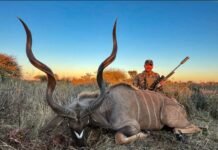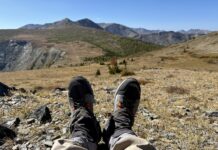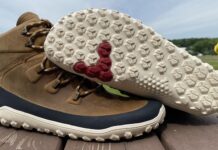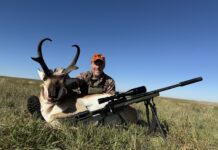Backcountry Boots
By Rokslide Staff
Simply put, boots are one of the most important pieces of gear in your hunting arsenal. They can literally make or break your hunt. For the hardcore, DIY type hunter, a quality pair of boots is a must. Lesser quality boots should be avoided at all cost!
Several Rokslide staff members have come together and contributed input on what boots they prefer to use for both early and late season, and probably more importantly, why they use them!

David Long
I still remember the day my first pair of Kenetrek Mountain Extremes showed up on my door step. I was being sponsored by another boot company at that time and I was considering shipping the Kenetreks back. But before I did that, I wanted to at least try them on, so I opened up the box and slipped them on. Immediately, I loved the feel and support they offered. Needless to say, that very day I switched boot companies and have been using Kenetrek boots ever since. The Mountain Extremes by Kenetrek offer a lot more support than most boots I have tried in the past. Considering I traverse rockslides and extreme slopes in the areas I typically hunt, support is high on my list. Another reason I use them is because they are 100% leather. I have not had good luck with boots that combine leather and Cordura. It seems they always part at the seams after a hard season of hunting up in the rocks. Because these boots do offer a great amount of support, they do require a break-in period. I would highly recommend putting 50 miles on the Mountain Extremes before wearing them into the backcountry.
Early season boots: When packing a heavy load, I prefer the un-insulated Kenetrek Mountain Extremes – hands down. On day hunts or when I have a light pack, I use the Hanwag Mountain Light GTX’s by Lathrop & Sons.
Late season boots: the 1000 gram insulated Kenetrek Mountain Extremes.
Aron Snyder
My boot of choice for early season hunting is Hanwag Mountain Lights from Lathrop and Sons. I’m not a big fan of all leather boots during the summer and early fall months and the Mountain Lights offer plenty of support, comfort and durability in any conditions that I have hunted. A few of the key ingredients to the Mountain Lights durability is the ballistic Cordura they are made from and the elevated rubber rand that wraps around the entire boot. The ballistic Cordura helps keep the weight down (3.3 lbs) and with all of these factors combined, this boot is a great choice for any backpack hunter. On all my late season hunts I prefer the Hanwag Alaska GTX; these boots are full grain upper leather and that adds to the overall warmth when compared to a synthetic. The Alaskan’s also offer an elevated rubber rand that wraps around the entire boot to add to the overall durability. I have used both of these boots on several hunts either of them will hold up to any conditions you can throw at them.
Nate Simmons
Early Season Boots
When it comes to my early season bowhunting boots, I prefer a mid height boot in the 6” range to allow for greater range of motion when stalking, crawling, climbing, etc. Another thing I look for is a good combination of support for heavy loads yet that still has “feel” for quiet walking and stalking. Value is also high on my list, so a boot that will last multiple seasons in the rugged high country will save me money. Last but not least, the fit has to be perfect as I know from experience that there are few things that can spoil a backcountry hunt as fast as a bad blister. I have used a different make and/or model boot every hunting season for a while now, and there are a handful of boots I have tested that I’m pretty happy with. My current fling is with the Schnee’s Wilderness boot. It weighs in at 3.1 pounds per pair and retails for $289. While I have never found a “perfect” boot, this boot ranks high in all the major categories I mentioned above that are important to me.
Late Season Boots
This topic has always been a tough one for me, I have just never found a “late season” boot I cared for. I just can’t stand any boot for hiking that weighs over 3.5 lbs or is over 8” high. It doesn’t take much insulation in a boot before my feet start sweating bad enough I get blisters. This sucks because I get cold feet really fast and it’s hard for me to warm them back up once they get cold. So, here is what my late season boot system entails: If the weather is extremely cold and I’m not going to be doing any intense hiking whatsoever, I prefer Schnee’s Hunter II Pac Boot ($199). This boot is very water resistant and warm. It is also heavy, but that’s alright if I’m not planning any intense hiking. The trade off in this situation is worth it for the warmth and waterproof aspect. Often, however, I do plan on some intense hiking on late season hunts; in this situation I will often wear the same boot I use for early season hunts coupled with Kenetrek gaiters ($60) to help keep water/snow out when needed. But my feet still get cold fast anytime I stop hiking, so I have started packing boot insulators by ArcticShield that I found at Cabelas for $50. These are basically a slip on boot cover that acts as a winter coat for your feet. They go on and off quickly and I have found that if I put them on as soon as I sit down to glass while my feet are still warm from hiking, my feet stay fairly warm. In extremely cold conditions I will place a air activated hand warmer inside the bootie and that does the trick. These are also nice to slip over your feet at night for keeping your feet warm when sleeping. These are not designed for use when hiking, but for me, it’s a nice way to avoid having to wear big, heavy clunky boots and still be comfortable when it’s cold and wet.
Amy Hanneman
Hunting Boots
Hands down my boot of choice is the Women’s Kenetrek Mountain Extreme. I wear them for my early and late season hunts and will switch to my Kenetrek Grizzly Pac boot if the snow is deep enough.
Late Season Hunting Boots
For my late season hunts I wear Kenetrek Mountain Extreme 1000 gram insulated boots until the snow here in Montana gets to deep and then I switch to the Kenetrek Grizzly Pac boot. Both boots have worked well for me in the past. I also replace the Mountain Extreme 1000 insoles with Super feet insoles.
Robby Denning
Right up front, I need to say I’m not a hunter who walks a lot of miles per day. I use horses to access the backcountry and do a lot of glassing once I’m there, so I only walk about three or less miles a day most days. I also have the luxury of carrying a second pair of heavier waterproof boots in my panniers. Therefore, I can get by with a lighter, less expensive boot than guys who are backpacking many miles with heavy pack.
From the opening of archery season in late August, I prefer lightweight hiking shoes for dry weather. The Hi-Tec Haka Trail Men’s Waterproof Light Hiking boot is a great choice. Although it’s advertised as waterproof, it doesn’t have a traditional Gore-Tex liner. The boots employ a water proof suede leather and seam-sealed construction. Water repellant is probably a more accurate description as my feet do get wet if it’s raining much. However, I don’t like Gore-Tex unless it is raining; my feet sweat too much and the boots are hard to dry out once wet. The non-Gore-Tex construction is more comfortable and easy to dry.
From the beginning of October until the snow and cold hits, I wear Danner boots with 400 grams of Thinsulate and Gore-Tex liner. Danner has several models that fit the bill.
Once late October rolls around, I wear a traditional rubber bottom pack boot with a removable liner. I spend a ton of time in the saddle and glassing, so I have to wear a pretty warm boot. I currently own a pair made by Schnees, called the Hunter II. Being able to take the liner out at night makes them much easier to dry than non-liner boots.
To be honest, I’ve never found boots warm enough (that you can actually walk in) for the cold and snow when using horses. About five years ago, I started using the Grabber Foot Warmers. This is an air-activated boot warmer that is shaped like the insole of a shoe. They provide about five hours of warmth, enough to get through the coldest hours around sunrise. They don’t slide around or bunch up due to the insole design. You have to buy them in your size for the best results. Call me a wimp, but I never have cold feet anymore.
Luke Moffat
When I think “late season” I envision snow and temp down into the teens or colder. Having boots you can rely on to keep your feet warm, dry, and supported in the mountains is a must. The last place you want to find your boots are sub par is many miles from the truck with wet/cold feet. For me, me go to boots are the Lowa Sheephunter (or Lowa Hunter GTXs). These boots fit my feet like a glove. They have the right amount of insulation to keep my feet warm even down to 0 degrees or slightly colder, while not being too warm and causing my feet to sweat too much even at 70 degrees. These Lowas have a ¾ length shank which, for me, provides the perfect balance of great support while side-hilling a steep slope with a pack full of meat as well as comfortable to log a 20+ mile day hiking in to get into your hunting location. Late season also means snow and ice on the mountain slopes, so a boot that works well with instep crampons is a must for keeping you glued to the slippery slopes. The Lowa Sheephunters work extremely well with instep crampons in my experience. Of course boot fit, like packs, is a very personal thing so ensuring a certain boot works for YOUR feet is essential prior to venturing out into the backcountry.



















